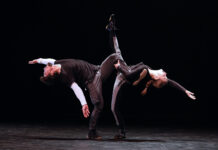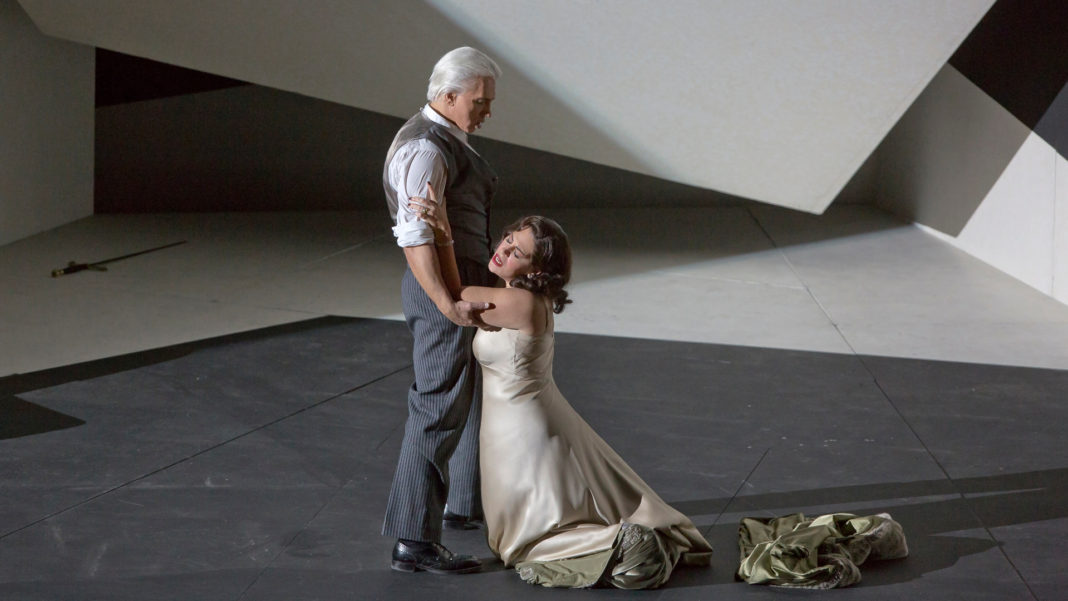Your votes have been cast. From 112 productions that were streamed by the Metropolitan Opera during the pandemic, the operas showing during Week 71 at the Met are your choices as the productions to close out their streaming programming. Yes, this is truly the final week.
The opera star appearing in the most productions is the late baritone Dmitri Hvorostovsky who appears in the final two productions being streamed. The composer being represented the most is, no surprise, Verdi. In fact, Hvorostovsky singing Verdi received the top vote. That opera (see below for the reveal) is the final streaming production.
All productions become available at 7:30 PM EST/4:30 PM PST and remain available for 23 hours. Schedules and timings may be subject to change.
The Met is heavily promoting theplanned resumption of performances in the 2021-2022 season, so you’ll have to go past those announcements and promos to find the streaming productions on the Metropolitan Opera website.
If you read this column early enough on July 19th, you’ll still have time to see the 2015-2016 season production of Puccini’s Turandot that concludes Puccini week.
Here is are selections for Week 71 at the Met:
Monday, July 19 – Mozart’s Le Nozze di Figaro – 3rd Showing
Conducted by James Levine, starring Renée Fleming, Cecilia Bartoli, Susanne Mentzer, Dwayne Croft, and Sir Bryn Terfel. This Jonathan Miller production is from the 1998-1999 season.
Mozart’s Le Nozze di Figaro is based on the 1784 play La folle journée, ou le Mariage de Figaro (translated: “The Mad Day, or The Marriage of Figaro”) by Pierre Beaumarchais. Lorenzo da Ponte wrote the libretto. La Nozze di Figaro had its world premiere in Vienna in 1786.
Figaro and Susanna are getting married. They are in a room made available to them by the Count who plans to seduce the bride-to-be based on an old law that gave permission to lords to have sex with servant girls on their wedding night. When Figaro gets wind of this plan he enlists several people to outwit the Count using disguises, altered identities and more.
Bernard Holland, reviewing for the New York Times, said of this production: “One cannot say enough about the septet ending Act II and the final ensemble of Act IV: episodes in which theater and music merged as they rarely do, and where each player was made exquisitely aware of every other. Mozart operas move on the wheels of their ensembles, and Mr. Miller — with no coups de theatre and many acts of self-effacing care — made them turn.”
Tuesday, July 20 – Mascagni’s Cavalleria Rusticana and Leoncavallo’s Pagliacci – 2nd Showing
Both operas conducted by James Levine. Cavalleria Rusticana starring Tatiana Troyanos, Jean Kraft, Plácido Domingo and Vern Shinall. Pagliacci starring Teresa Stratas, Plácido Domingo, Sherrill Milnes and Allan Monk. This Franco Zeffirelli production is from the 1977-1978 season.
Perhaps no pairing of one-act operas is more popular than the combination of Cavalleria Rusticana by Pietro Mascagni and Pagliacci by Ruggero Leoncavallo.
Cavalleria Rusticana had its world premiere in Rome in 1890. The opera is based on a short story which later became a play by Giovanni Verga. Giovanni Targioni-Tozzetti and Guido Menasci adapted them both for their libretto.
Mascagni’s opera centers on a love triangle. Turridu, who has returned from military service, goes to see his ex-lover, Lola, before seeing his current lover, Santuzza. Lola is married to Alfio. Santuzza decides to tell Alfio about the infidelity and the two men decide to duel. At the end of the opera, multiple hearts are left broken.
Pagliacci had its world premiere in Milan in 1892. Leoncavallo also wrote the libretto.
The opera tells the story of a married couple, Canio and Nedda, who are performers in a small theatre company on the road. Canio is insanely jealous and that jealousy drives Nedda to seek affection from another man, Silvio. Nedda and Silvio make plans to elope, but their plans are overheard by Tonio, another member of the company. He tells Canio about Nedda’s plans. Looking for revenge, Canio, during a performance of their touring play, makes his personal life mirror the drama in the play.
This was not the first time Domingo had sung the lead tenor roles in both operas on the same night. In fact, with this performance he did so for the 25th time. Previous double-hitters were performed in Vienna, Covent Garden and in San Francisco. These performances also marked the first time James Levine conducted each opera at the Met.
Wednesday, July 21 – Bizet’s Les Pêcheurs de Perles – 4th Showing
Conducted by Gianandrea Noseda; starring Diana Damrau, Matthew Polenzani, Mariusz Kwiecień and Nicolas Testé. This Penny Woolcock production is from the 2015-2016 season.
Les Pêcheurs de Perles (best known to many as The Pearl Fishers) had its world premiere in 1863 in Paris. Bizet’s opera has a libretto written by Eugène Cormon and Michel Carré.
The setting is the island of Ceylon (present-day Sri Lanka) and two men find that their plan to be friends forever regardless of circumstances is threatened when they both fall in love with the same woman. She, too, is conflicted as she has sworn to be a priestess, but finds herself falling in love with the men.
Director Woolcock’s production was new to the Met when it debuted on New Year’s Eve 2015. The production was first staged at the English National Opera in 2010. The last time Les Pêcheurs de Perles had been performed at the Met was 1916.
Thursday, July 22 – Offenbach’s Les Contes d’Hoffmann – 2nd Showing
Conducted by Yves Abel; starring Erin Morley, Hibla Gerzmava, Kate Lindsey, Christine Rice, Vittorio Grigolo and Thomas Hampson. This revival of the 2009 Bartlett Sher production is from the 2014-2015 season.
Jacques Offenbach’s Les Contes d’Hoffman had its world premiere in Paris in 1881. The libretto was written by Jules Barbier and was inspired by three short stories by Ernst Theodor Amadeus Hoffman. Offenbach did not live to see this opera performed. He died four months before its premiere.
In the opera Offenbach and Barbier put the author of the stories in the middle of all the action. He’s seeking perfect love and tells a tavern crowd about three fruitless attempts at romance. The first with the daughter of an inventor who turns out to be a doll instead of a human being. The second with a beautiful young woman with a gorgeous voice, but whose singing may lead to her death. The third with a young woman who steals his reflection. Will poor Hoffman ever find love? Or will his writing be his lifelong companion?
In David Shengold’s Opera News review of this production he raved about Grigolo’s performance:
“…Grigolo may have found his most convincing Met part yet. His French is remarkably clear and accurate for an Italian tenor and — though he deployed his full resources at climaxes, often excitingly — Grigolo showed admirable dynamic variety in filling out Offenbach’s higher lines. His soft singing wasn’t exactly Gallic classic voix mixte but he integrated it gracefully into his overall vocalization, clear and attractive save for rather empty low notes. Grigolo paced himself well in this extremely demanding assignment; he tended to be placed near the lip of the stage, but he interacted with colleagues and created an actual character.”
Friday, July 23 – Donizetti’s La Fille du Régiment – 3rd Showing
Conducted by Marco Armiliato; starring Natalie Dessay, Felicity Palmer, Juan Diego Flórez and Alessandro Corbelli. This Laurent Pelly production is from the 2007-2008 season.
This two-act comic opera written by Gaetano Donizetti was first performed in 1840 in Paris. The libretto is by Jules-Henri Vernoy de Saint-Georges and Jean-François Bayard.
La Fille du Régiment tells the story of a young woman, Marie, who was raised by the 21st Regiment after having been found as a baby on a battlefield. The plan is that when she is old enough she will marry one of the men of the Regiment. She falls in love with Tyrolean Tonio. When the Marquise de Berkenfield shows up, it is discovered that she is Marie’s aunt and she wants to take Marie away to raise her as a lady. Will love win out for Marie?
Pelly updated the original Napoleonic war setting to World War I for this production. The end result, according to several critics, was that the “war is hell” concept is undermined by the silliness of the plot.
One of the hallmarks of this opera is the challenge that faces every tenor singing the role of Tonio to hit nine high C’s in the opera’s best known aria, “Ah! mes amis.” Flórez nailed them and, of course, repeated the aria to wild applause from the audience.
Saturday, July 24 – Verdi’s Il Trovatore – 3rd Showing
Conducted by Marco Armiliato; starring Anna Netrebko, Dolora Zajick, Yonghoon Lee, Dmitri Hvorostovsky and Štefan Kocán. This revival of David McVicar’s 2009 production is from the 2014-2015 season.
Giuseppe Verdi’s Il Trovatore is based on the play El trovador by Antonio García Gutiérrez published in 1836. The libretto was written by Salvadore Cammarano with additions by Leone Emanuele Badare. The opera had its world premiere in Rome in 1853.
The setting is Zaragoza, the capital of the Kingdom of Aragon, circa 1412. To offer up a quick synopsis here would be a fool’s game to play. Several stories happen simultaneously and sometimes share the same characters. The opera has rarely been hailed for its story, but it certainly ranks as one of Verdi’s finest compositions.
This production of Il Trovatore took place months after Hvorostovsky’s diagnosis of cancer. This was his last production at the Met and as you could tell at the start of the clip above, he was beloved by the audience.
Anthony Tommasini’s review in the New York Times said that positively influenced the performance Hvorostovsky gave on opening night.
“It’s impossible to imagine a singer giving more than Mr. Hvorostovsky did on this night. When your life is actually threatened by a serious illness, you truly are putting everything on the line when you sing.
“Mr. Hvorostovsky gave a gripping performance as Count di Luna. There was little need to take what he has been going through into account. His resplendent voice, with its distinctive mellow character and dusky veneer, sounded not at all compromised. He sang with Verdian lyricism, dramatic subtlety and, when called for, chilling intensity as the complex count, who, in this production, with its Goya-inspired imagery, is the brash leader of the Royalist Aragon troops at a time of bloody civil war in Spain.”
Sunday, July 25 – Verdi’s Un Ballo in Maschera – 4th Showing
Conducted by Fabio Luisi; starring Sondra Radvanovsky, Kathleen Kim, Stephanie Blythe, Marcelo Álvarez and Dmitri Hvorostovsky. This David Alden production is from the 2012-2013 season.
Verdi’s opera, translated A Masked Ball, had its premiere in Rome in 1859. Librettist Antonio Somma used the libretto written by Eugène Scribe for the opera, Gustave III, ou Le Ballo masqué, written by Daniel Auber in 1833.
The opera is based on the real life assassination of King Gustav III of Sweden who was killed while attending a masquerade ball in Stockholm.
Verdi takes some dramatic liberties which certainly enhances the drama. Riccardo is in love with Amelia. She, however, is the wife of his good friend and confidante, Renato. Riccardo is warned by his friend that there is a plot to kill him at the ball. Paying no attention to the warning, Riccardo instead seeks out Ulrica, a woman accused of being a witch. In disguise he visits Ulrica to have his fortune read. She tells him he will be killed by the next man who shakes his hand. That next man turns out to be Renato. What follows is a story of intrigue, deception, questions of fidelity and, of course, the assassination.
This was a brand new production of Un Ballo in Maschera at the Met. Director Alden was influenced by black and white films and, in particular, film noir for his production.
Karita Matilla was originally announced to sing the role of Amelia. She withdrew approximately six months prior to its staging. Radvanovsky assumed the role.
In his New York Times review, Anthony Tommasini said of Radvanovsky and Hvorostovsky, “She was particularly moving in the scene in which her husband, here the charismatic baritone Dmitri Hvorostovsky, having discovered her in a rendezvous with the king, tells her to prepare to die. Confronting his wife, Mr. Hvorostovsky shook Ms. Radvanovsky by the shoulders, as if really ready to strangle her. But the next moment he nestled his head next to her face and kissed her, almost pleadingly, singing with his trademark dark sound and supple phrasing, which poignantly brought to life this suffering husband’s love.”
It’s been quite a run of streaming productions. But all good things must come to an end.
Enjoy the operas! Enjoy your week!
Photo: Dmitri Hvorostovsky and Sondra Radvanovsky in Un Ballo in Maschera











